Bayesian Framework for Detecting Changes in Downstream Flow–Duration Curves Induced by Reservoir Operation Method
Abstract
1. Introduction
2. Methodology
2.1. Bayesian Framework
2.2. Determination of the Likelihood Function for Each ROM
2.3. Derivation of Posteriori Distribution for Each ROM
- (1)
- Determination of the inflow hydrograph.
- (2)
- Probability distribution of peak flow.
- (3)
- Determination of the priori distribution.
- (4)
- Combination of the priori distributions and likelihood functions.
- (5)
- Derivation of the posteriori distribution for each peak flow.
- (6)
- Probability distribution of the outflow.
3. Study Area and Data
4. Results and Discussion
4.1. Verification of the Bayesian Replacement for the ROMs
4.2. Effect of the Dam Operation on the Downstream Flow–Duration
4.3. Multiple Dams and Changes of Downstream Flow–Durations
4.4. Implications and Limitations
5. Summary and Conclusions
Supplementary Materials
Author Contributions
Funding
Data Availability Statement
Conflicts of Interest
References
- Choi, S.U.; Yoon, B.; Woo, H. Effects of dam-induced flow regime change on downstream river morphology and vegetation cover in the Hwang River, Korea. River Res. Appl. 2005, 21, 315–325. [Google Scholar] [CrossRef]
- Wang, Y.; Rhoads, B.L.; Wang, D. Assessment of the flow regime alterations in the middle reach of the Yangtze River associated with dam construction: Potential ecological implications. Hydrol. Process. 2016, 30, 3949–3966. [Google Scholar] [CrossRef]
- Magilligan, F.J.; Nislow, K.H. Changes in hydrologic regime by dams. Geomorphology 2005, 71, 61–78. [Google Scholar] [CrossRef]
- Mineda, H.; Nukazawa, K.; Suzuki, Y. Assessing environmental flow alterations induced by dams and climate change using a distributed hydrological model at catchment scale. J. Water Clim. Change 2023, 14, 4821–4836. [Google Scholar] [CrossRef]
- Karimidastenaei, Z.; Darabi, H.; Torabi Haghighi, A. Impact of dam construction on suspended sediment load alteration. In Proceedings of the EGU General Assembly Conference Abstracts, Vienna, Austria, 14–19 April 2024; p. 5559. [Google Scholar]
- Bussi, G.; Darby, S.E.; Whitehead, P.G.; Jin, L.; Dadson, S.J.; Voepel, H.E.; Vasilopoulos, G.; Hackney, C.R.; Hutton, C.; Berchoux, T.; et al. Impact of dams and climate change on suspended sediment flux to the Mekong delta. Sci. Total Environ. 2021, 755, 142468. [Google Scholar] [CrossRef]
- Yoon, Y.N.; Kang, B.S.; Kim, U.T.; Kim, J.H.; Ko, I.H. An analysis on the variation of long-term runoff characteristics of basin before and after dam construction II. An analysis on the variation of long-term runoff characteristics of basin using model parameters estimation. J. Korean Soc. Civ. Eng. 1998, 18, 461–468. [Google Scholar]
- Yoo, C.; Kim, J.K.; Kim, J.H.; Yoon, Y.N. Change of hydrometeorologic environment due to dam construction: 1. Estimation of changing point. J. Korean Soc. Civ. Eng. 2003, 23, 87–94. [Google Scholar]
- Yoo, C.; Kim, K.; Yoon, Y. Change of hydrometeorologic environment due to dam construction: 2. Change of means. J. Korean Soc. Civ. Eng. 2003, 23, 95–103. [Google Scholar]
- Choi, S.; Yoon, B.; Woo, H.; Cho, K.H. Effect of flow-regime change due to damming on the river morphology and vegetation cover in the downstream river reach: A case of Hapchon dam on the Hwang river. J. Korea Water Resour. Assoc. 2004, 37, 55–66. [Google Scholar] [CrossRef]
- Ahn, J.H.; Yoo, C.; Kim, H.Y.; Yoon, Y.N. An assessment on the geographical boundary of hydrometeorologic changes due to dam construction. J. Korea Water Resour. Assoc. 2005, 38, 293–300. [Google Scholar] [CrossRef]
- Poff, N.L.; Allan, J.D.; Bain, M.B.; Karr, J.R.; Prestegaard, K.L.; Ricther, B.D.; Sparks, R.E.; Stromverg, J.C. The natural flow regime: A paradigm for river conservation and restoration. Bioscience 1997, 47, 769–784. [Google Scholar] [CrossRef]
- Chen, Y.D.; Yang, T.; Xu, C.Y. Hydrologic alteration along the Middle and Upper East River (Dongjiang) basin, South China: A visually enhanced mining on the results of RVA method. Stoch. Environ. Res. Risk Assess. 2010, 24, 9–18. [Google Scholar] [CrossRef]
- Yang, Z.; Yan, Y.; Liu, Q. Assessment of the flow regime alterations in the Lower Yellow River, China. Ecol. Inform. 2012, 10, 56–64. [Google Scholar] [CrossRef]
- Rood, S.B.; Samuelson, G.M.; Braatne, J.H.; Gourley, C.R.; Hughes, F.M.R.; Mahoney, J.M. Managing river flows to restore floodplain forests. Front. Ecol. Environ. 2005, 3, 193–201. [Google Scholar] [CrossRef]
- Burke, M.; Jorde, K.; Buffington, J.M. Application of a hierarchical framework for assessing environmental impacts of dam operation: Changes in streamflow, bed mobility and recruitment of riparian trees in a western North American river. J. Environ. Manag. 2009, 90, S224–S236. [Google Scholar] [CrossRef]
- Mediero, L.; Garrote, L.; Martin-Carrasco, F. A probabilistic model to support reservoir operation decisions during flash floods. Hydrolog. Sci. J. 2007, 52, 523–537. [Google Scholar] [CrossRef]
- Zhang, Y.Y.; Xia, J.; Chen, J.F.; Zhang, M.H. Water quantity and quality optimization modeling of dams operation based on SWAT in Wenyu River catchment, China. Environ. Monit. Assess. 2011, 173, 409–430. [Google Scholar] [CrossRef]
- K-Water. Dam Operation Manual; K-Water: Daejeon, Republic of Korea, 2009. [Google Scholar]
- Lee, S.J. Development of Weather Forecast Correction Method and Application to Dam Operation. Master’s Thesis, Sejong University, Seoul, Republic of Korea, 2011. [Google Scholar]
- Huh, J.G. A Study on Operation of Reservoir Using Simulation Technique. Master’s Thesis, Soong-sil University, Seoul, Republic of Korea, 2016. [Google Scholar]
- K-Water. A Guidance for Practical Design of Hydraulic Structures: Dam (Investigation and Planning); K-Water: Daejeon, Republic of Korea, 2018. [Google Scholar]
- Yoo, C.; Shin, H.; Lee, J. Evaluation of the Storage Effect Considering Possible Redevelopment Options of the Peace Dam in South Korea. Water 2020, 12, 1674. [Google Scholar] [CrossRef]
- Karamouz, M.; Vasiliadis, H.V. Bayesian stochastic optimization of reservoir operation using uncertain forecasts. Water Resour. Res. 1992, 28, 1221–1232. [Google Scholar] [CrossRef]
- Kim, Y.O.; Palmer, R.N. Value of seasonal flow forecasts in Bayesian stochastic programming. J. Water Resour. Plan. Manag. 1997, 123, 327–335. [Google Scholar] [CrossRef]
- Kim, Y.O.; Eum, H.I.; Kim, S.U.; Lee, K.S. Monthly joint operations for the Nakdong multi-reservoir system in Korea. Water Int. 2007, 32, 416–427. [Google Scholar] [CrossRef]
- Liu, Y.; Qin, H.; Zhang, Z.; Yao, L.; Wang, Y.; Li, J.; Liu, G.; Zhou, J. Deriving reservoir operation rule based on Bayesian deep learning method considering multiple uncertainties. J. Hydrol. 2019, 579, 124207. [Google Scholar] [CrossRef]
- Ang, A.H.S.; Tang, W.H. Probability Concepts in Engineering Planning and Design; Wiley: New York, NY, USA, 1984. [Google Scholar]
- Bates, B.C.; Campbell, E.P. A Markov chain Monte Carlo scheme for parameter estimation and inference in conceptual rainfall-runoff modeling. Water Resour. Res. 2001, 37, 937–947. [Google Scholar] [CrossRef]
- Viglione, A.; Merz, R.; Salinas, J.L.; Blöschl, G. Flood frequency hydrology. Part III: A Bayesian analysis. Water Resour. Res. 2013, 49, 675–692. [Google Scholar] [CrossRef]
- Brandt, F.T.; Das, A.; Frenkel, J.; Taylor, J.C. Kronecker delta energy terms in thermal field theory. Phys. Rev. D 2002, 65, 085008. [Google Scholar] [CrossRef][Green Version]
- Carbó-Dorca, R. Logical Kronecker delta deconstruction of the absolute value function and the treatment of absolute deviations. J. Math. Chem. 2011, 49, 619–624. [Google Scholar] [CrossRef]
- Koo, B.; Yoon, M.; Cho, S. Isogeometric shape design sensitivity analysis using transformed basis functions for Kronecker delta property. Comput. Method. Appl. Mech. Eng. 2013, 253, 505–516. [Google Scholar] [CrossRef]
- Liu, Y.; Gupta, H.V. Uncertainty in hydrologic modeling: Toward an integrated data assimilation framework. Water Resour. Res. 2007, 43, W07401. [Google Scholar] [CrossRef]
- Georgakakos, A.P.; Georgakakos, K.P.; Baltas, E.A. A state-space model for hydrologic river routing. Water Resour. Res. 1990, 26, 827–838. [Google Scholar]
- Namias, V. Application of the Dirac delta function to electric charge and multipole distributions. Am. J. Phys. 1977, 45, 624–630. [Google Scholar] [CrossRef]
- Prieto, F.; Lourenço, P.B.; Oliveira, C.S. Impulsive Dirac-delta forces in the rocking motion. Earthq. Eng. Struct. Dyn. 2004, 33, 839–857. [Google Scholar] [CrossRef]
- Engquist, B.; Tornberg, A.K.; Tsai, R. Discretization of Dirac delta functions in level set methods. J. Comput. Phys. 2005, 207, 28–51. [Google Scholar] [CrossRef]
- Eftekhari, S.A. A differential quadrature procedure with regularization of the Dirac-delta function for numerical solution of moving load problem. Lat. Am. J. Solids Struct. 2015, 12, 1241–1265. [Google Scholar] [CrossRef]
- Hjelmfelt, A.; Wang, M. General stochastic unit hydrograph. J. Irrig. Drain. Eng. 1994, 120, 138–148. [Google Scholar] [CrossRef]
- Monajemi, P.; Khaleghi, S.; Maleki, S. Derivation of instantaneous unit hydrographs using linear reservoir models. Hydrol. Res. 2021, 52, 339–355. [Google Scholar] [CrossRef]
- Lu, M.; Rogiers, B.; Beerten, K.; Gedeon, M.; Huysmans, M. Exploring river–aquifer interactions and hydrological system response using baseflow separation, impulse response modelling and time series analysis in three temperate lowland catchments. Hydrol. Earth Syst. Sci. 2022, 26, 3629–3649. [Google Scholar] [CrossRef]
- Bartlett, M.S.; Daly, E.; McDonnell, J.J.; Parolari, A.J.; Porporato, A. Stochastic rainfall-runoff model with explicit soil moisture dynamics. Proc. R. Soc. A Math. Phys. Eng. Sci. 2015, 471, 20150389. [Google Scholar] [CrossRef]
- Shin, Y.L.; Maeng, S.H.; Ko, I.H.; Lee, H.K. Development of reservoir operation model using simulation technique in flood season (I). J. Korea Water Resour. Assoc. 2000, 33, 745–755. [Google Scholar]
- Diskin, M.H.; Lane, L.J. Application of a Double Triangle Unit Hydrograph to a Small Semiarid Watershed; Arizona-Nevada Academy of Science: Glendale, AZ, USA, 1976. [Google Scholar]
- Kjeldsen, T.R. The Revitalised FSR/FEH Rainfall-Runoff Method; UK Centre for Ecology & Hydrology: Lancaster, UK, 2007. [Google Scholar]
- Luxon, N.; Christopher, M.; Pius, C. Validating the Soil Conservation Service triangular unit hydrograph (SCS-TUH) model in estimating runoff peak discharge of a catchment in Masvingo, Zimbabwe. Int. J. Water Res. Environ. Eng. 2013, 5, 157–162. [Google Scholar]
- SCS (Soil Conservation Service). National Engineering Handbook, Section 4: Hydrology; Soil Conservation Service: Washington, DC, USA, 1972.
- KNCOLD (Korea National Committee on Large Dams). The 40th Anniversary of the Korea National Committee on Large Dams: A History of Dam Design; Korea National Committee on Large Dams: Daejeon, Republic of Korea, 2012. [Google Scholar]
- Kim, H.T.; Shin, H. The development and application of GIS-based geomorpho-hydrological watershed model (G2WMS). J. Korean Soc. Hazard. Mitig. 2009, 9, 123–133. [Google Scholar]
- Molles, M.C., Jr.; Crawford, C.S.; Ellis, L.M.; Valett, H.M.; Dahm, C.N. Managed flooding for riparian ecosystem restoration: Managed flooding reorganizes riparian forest ecosystems along the middle Rio Grande in New Mexico. BioScience 1998, 48, 749–756. [Google Scholar] [CrossRef]
- Cross, W.F.; Baxter, C.V.; Donner, K.C.; Rosi-Marshall, E.J.; Kennedy, T.A.; Hall Jr, R.O.; Kelly, H.A.W.; Rogers, R.S. Ecosystem ecology meets adaptive management: Food web response to a controlled flood on the Colorado River, Glen Canyon. Ecol. Appl. 2011, 21, 2016–2033. [Google Scholar] [CrossRef] [PubMed]
- Puga, J.L.; Krzywinski, M.; Altman, N. Points of significance: Bayes’ theorem. Nat. Methods 2015, 12, 277–278. [Google Scholar] [CrossRef] [PubMed]
- Tonkin, J.D.; Merritt, D.M.; Olden, J.D.; Reynolds, L.V.; Lytle, D.A. Flow regime alteration degrades ecological networks in riparian ecosystems. Nat. Ecol. Evol. 2018, 2, 86–93. [Google Scholar] [CrossRef]
- Lu, X.; Gray, C.; Brown, L.E.; Ledger, M.E.; Milner, A.M.; Mondragón, R.J.; Woodward, G.; Ma, A. Drought rewires the cores of food webs. Nat. Clim. Chang. 2016, 6, 875–878. [Google Scholar] [CrossRef]
- Chalise, D.R.; Sankarasubramanian, A.; Ruhi, A. Dams and climate interact to alter river flow regimes across the United States. Earth’s Future 2021, 9, e2020EF001816. [Google Scholar] [CrossRef]
- Poff, N.L.; Olden, J.D.; Merritt, D.M.; Pepin, D.M. Homogenization of regional river dynamics by dams and global biodiversity implications. Proc. Natl. Acad. Sci. USA 2007, 104, 5732–5737. [Google Scholar] [CrossRef]
- Stein, E.D.; Zimmerman, J.; Yarnell, S.M.; Stanford, B.; Lane, B.; Taniguchi-Quan, K.T.; Obester, A.; Grantham, T.E.; Lusardi, R.A.; Sandoval-Solis, S. The California environmental flows framework: Meeting the challenges of developing a large-scale environmental flows program. Front. Environ. Sci. 2021, 9, 769943. [Google Scholar] [CrossRef]
- Shatnawi, A.; Ibrahim, M. Derivation of flood hydrographs using SCS synthetic unit hydrograph technique for Housha catchment area. Water Supply 2022, 22, 4888–4901. [Google Scholar] [CrossRef]
- Guo, J. General and analytic unit hydrograph and its applications. J. Hydrol. Eng. 2022, 27, 04021046. [Google Scholar] [CrossRef]
- dos Santos, C.I.; Carlotto, T.; Steiner, L.V.; Chaffe, P.L.B. Development of the Synthetic Unit Hydrograph Tool–SUnHyT. Appl. Comput. Geosci. 2023, 20, 100138. [Google Scholar] [CrossRef]
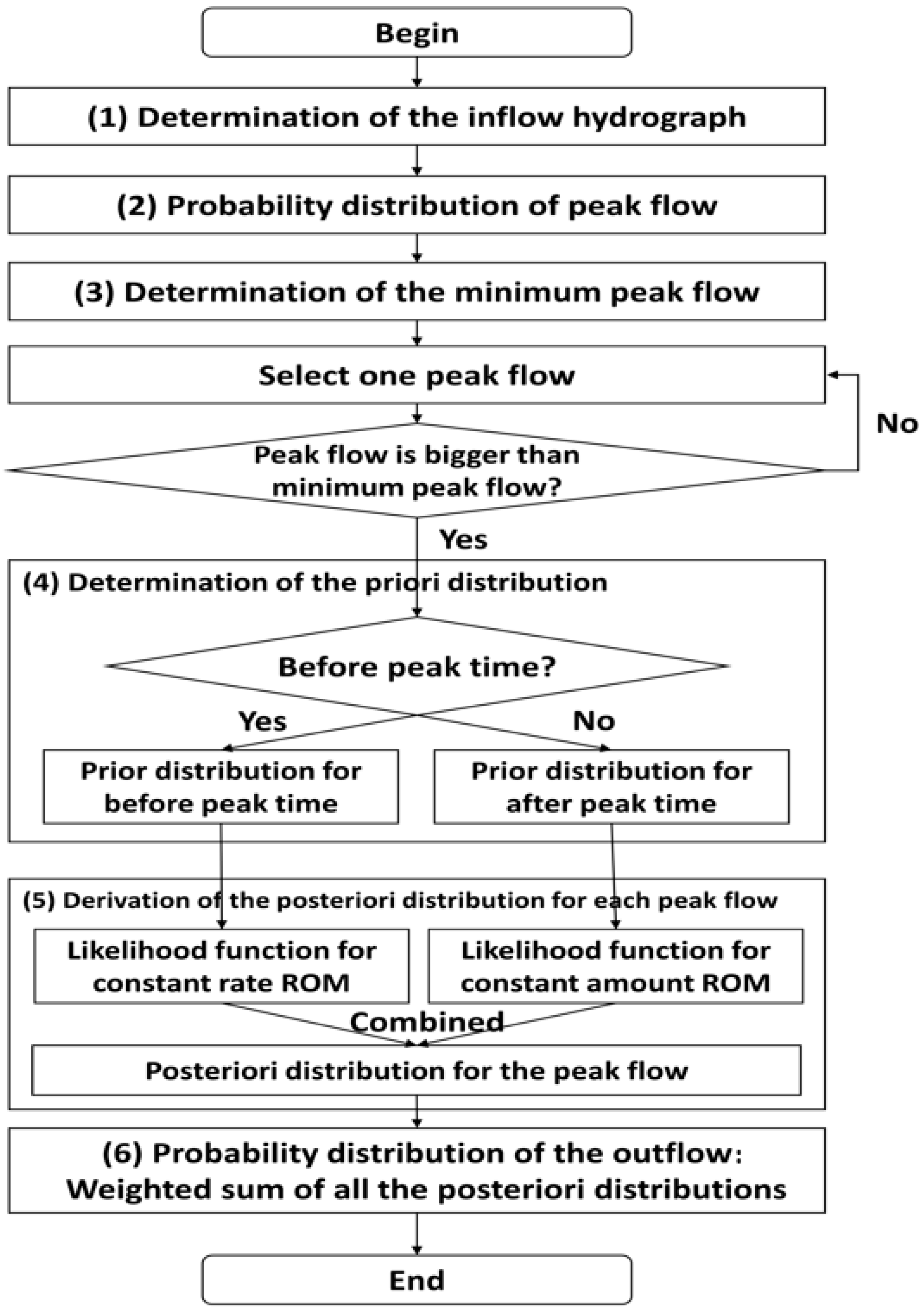
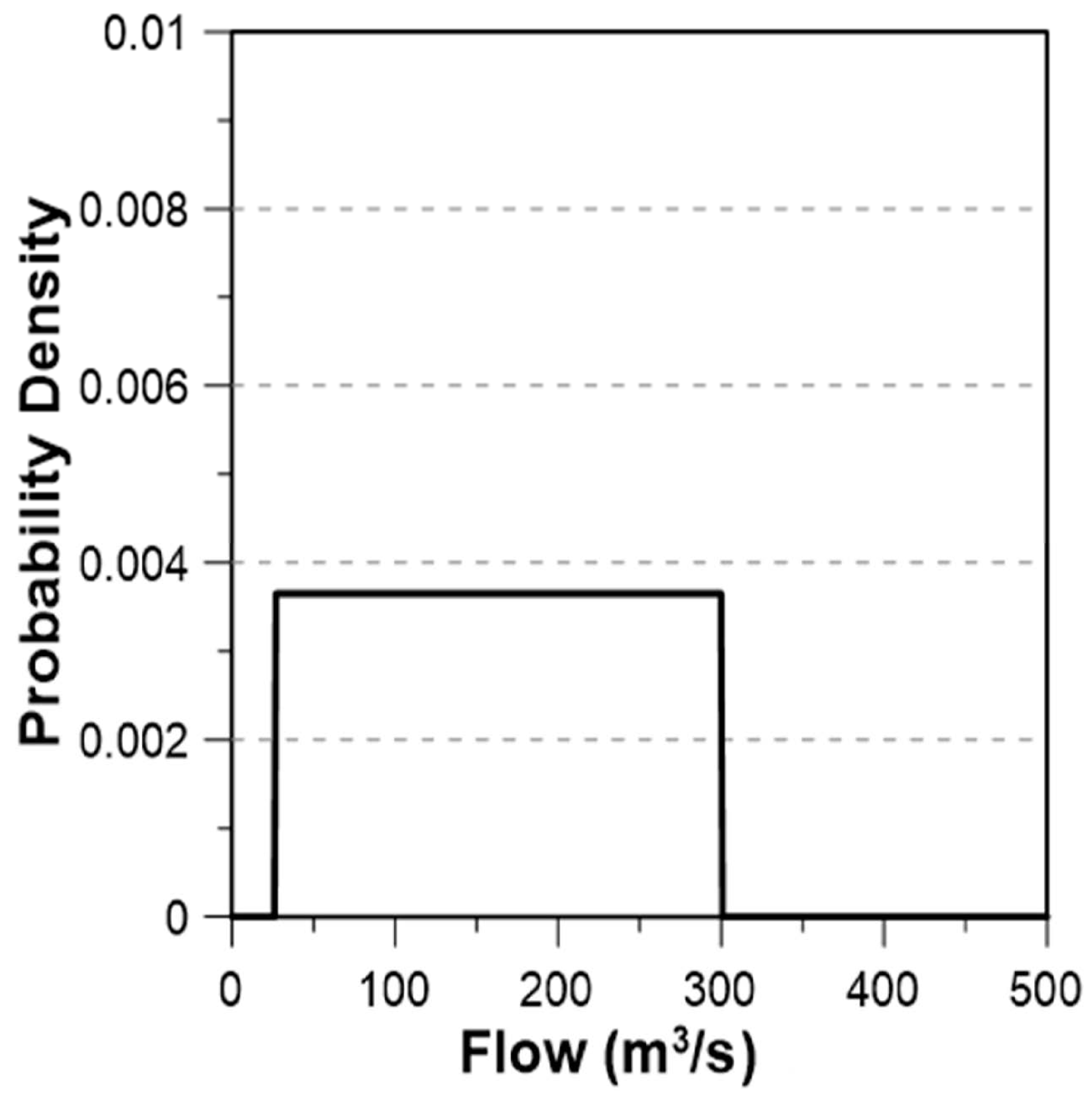
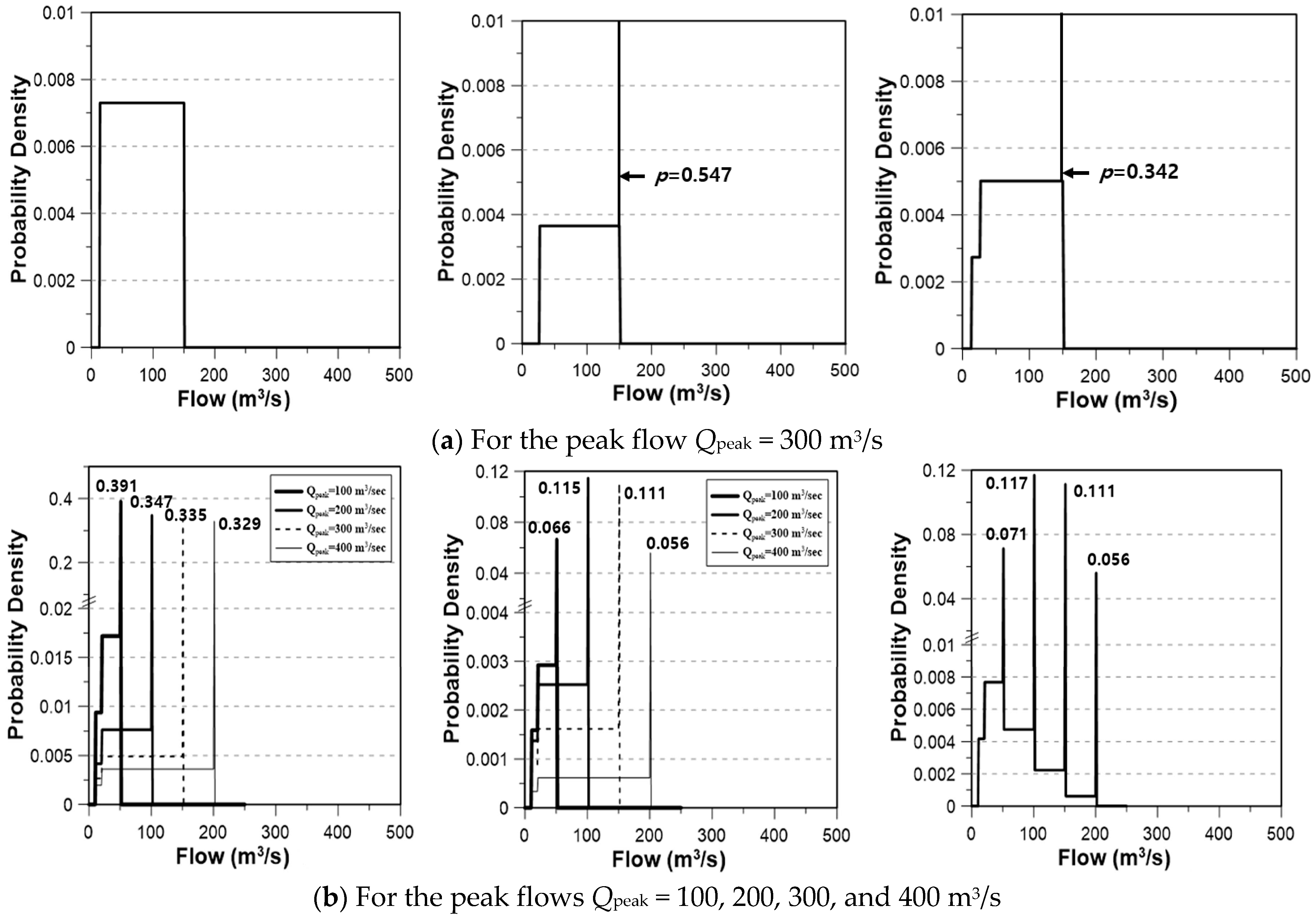

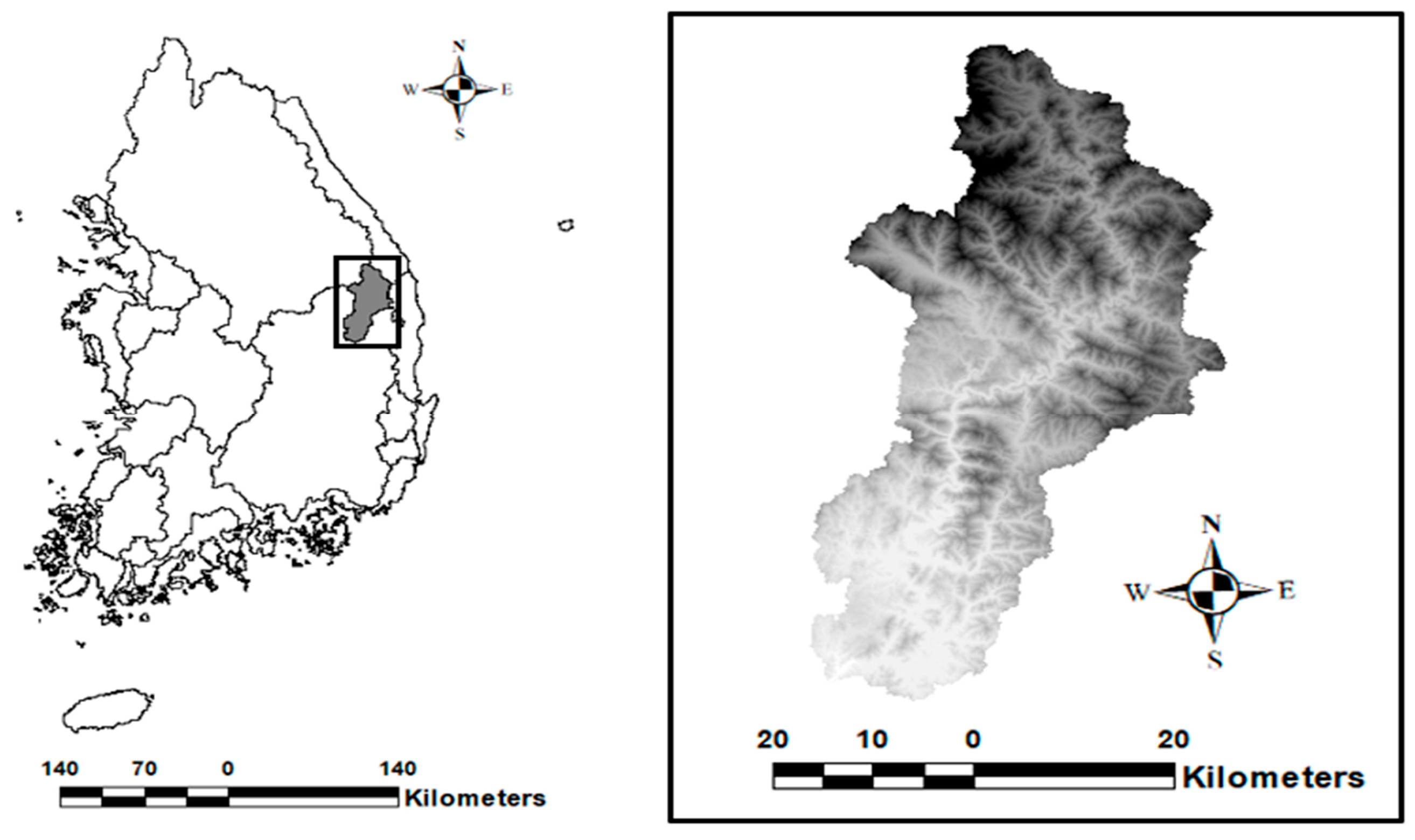
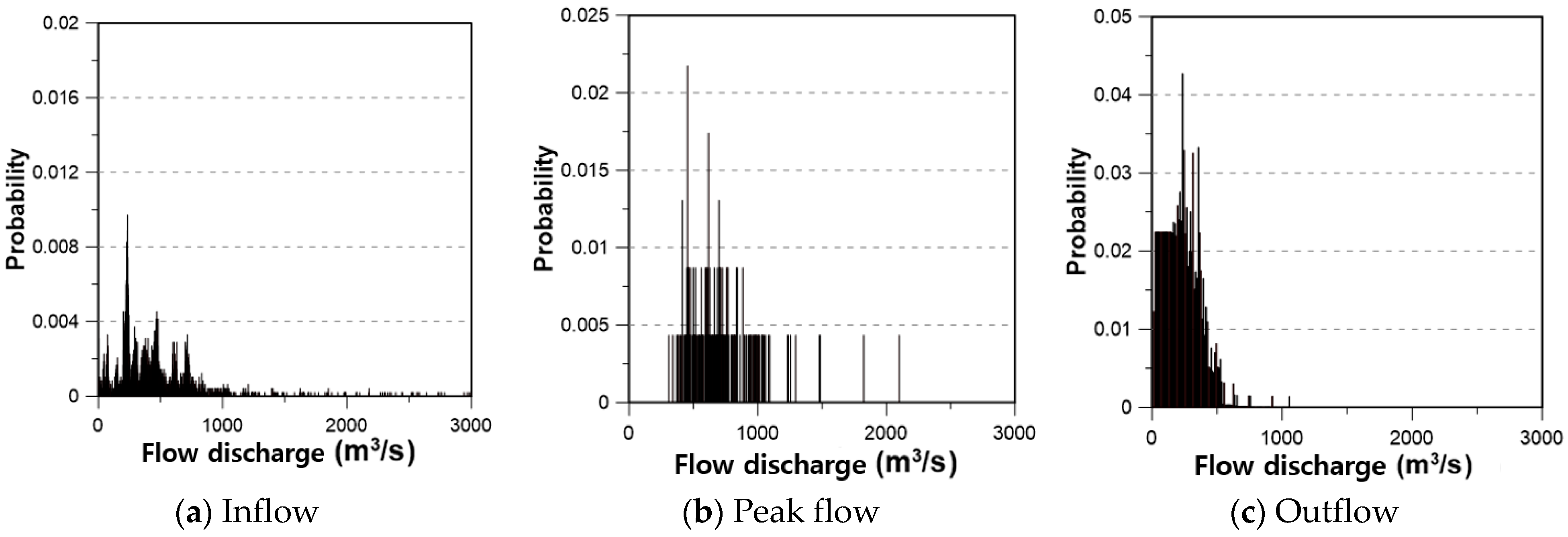

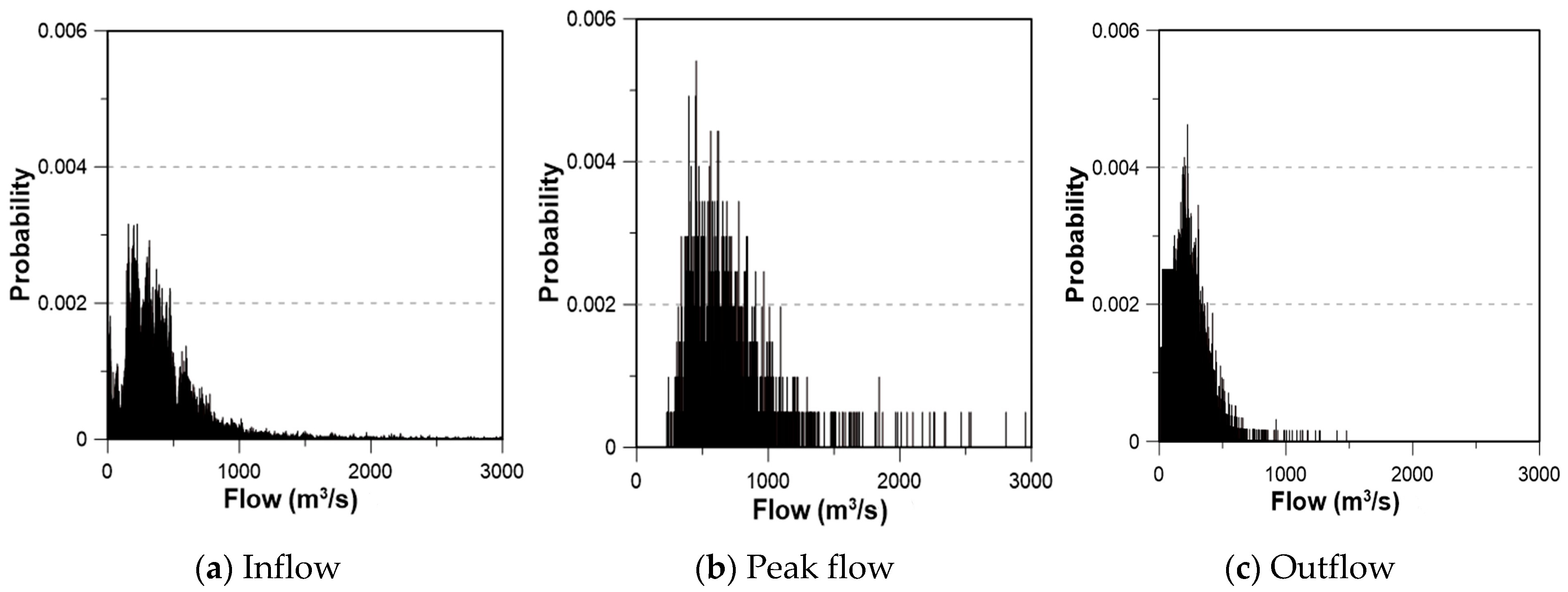
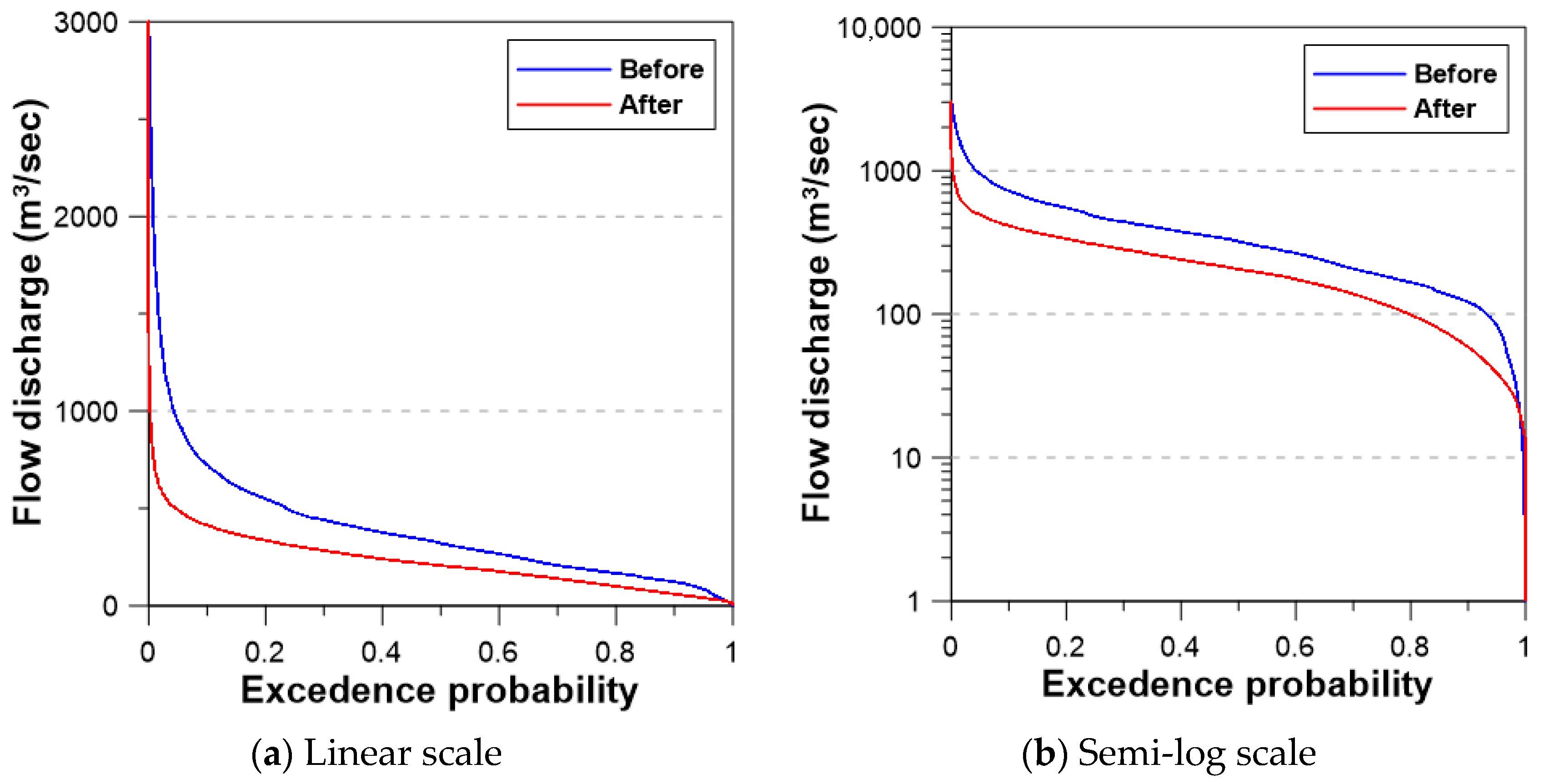

| 95-Day Flow (m3/s) | 185-Day Flow (m3/s) | 275-Day Flow (m3/s) | 355-Day Flow (m3/s) | Coefficient of Flow–Duration | |
|---|---|---|---|---|---|
| Before | 495 | 335 | 205 | 25 | 68 |
| After | 305 | 205 | 115 | 35 | 19 |
| Change (%) | −38 | −39 | −44 | 40 | −72 |
Disclaimer/Publisher’s Note: The statements, opinions and data contained in all publications are solely those of the individual author(s) and contributor(s) and not of MDPI and/or the editor(s). MDPI and/or the editor(s) disclaim responsibility for any injury to people or property resulting from any ideas, methods, instructions or products referred to in the content. |
© 2025 by the authors. Licensee MDPI, Basel, Switzerland. This article is an open access article distributed under the terms and conditions of the Creative Commons Attribution (CC BY) license (https://creativecommons.org/licenses/by/4.0/).
Share and Cite
Yoo, C.; Na, W. Bayesian Framework for Detecting Changes in Downstream Flow–Duration Curves Induced by Reservoir Operation Method. Water 2025, 17, 2078. https://doi.org/10.3390/w17142078
Yoo C, Na W. Bayesian Framework for Detecting Changes in Downstream Flow–Duration Curves Induced by Reservoir Operation Method. Water. 2025; 17(14):2078. https://doi.org/10.3390/w17142078
Chicago/Turabian StyleYoo, Chulsang, and Wooyoung Na. 2025. "Bayesian Framework for Detecting Changes in Downstream Flow–Duration Curves Induced by Reservoir Operation Method" Water 17, no. 14: 2078. https://doi.org/10.3390/w17142078
APA StyleYoo, C., & Na, W. (2025). Bayesian Framework for Detecting Changes in Downstream Flow–Duration Curves Induced by Reservoir Operation Method. Water, 17(14), 2078. https://doi.org/10.3390/w17142078







